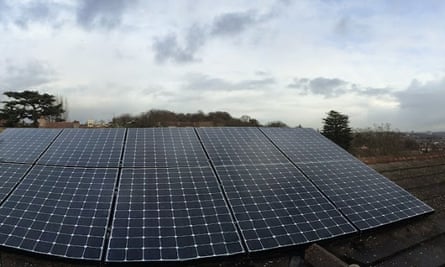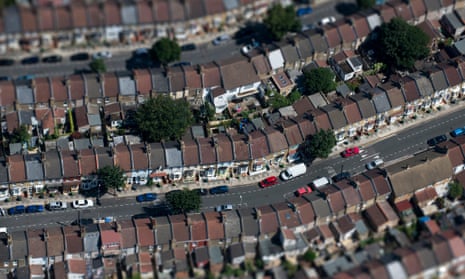In the end, it was a bit of an anticlimax. After years of wanting to stick solar panels on the roof of my London home, all I had to show for their installation earlier this month was a garden-full of scaffolding and a new box next to our fuse box.
Many people will understandably have written off solar power at home as the government incentives paid for them have been massively cut, sometimes so drastically that it prompted successful legal action against the coalition.
But what’s less frequently noted is how the £14,000 cost of a typical home installation when those incentives started in 2010 has fallen to £6,000-7,000, or even less. With a payback period of around seven years for the system I had installed, solar looks pretty attractive compared to ISAs paying around 1.5% interest, even in the capital.
Yet Londoners have not taken to solar with anything like the gusto of other parts of the country. Even with some of the most affluent areas in the UK and a relatively sun-friendly latitude by UK standards, the city has the lowest amount of installed solar of any English region.
This article includes content hosted on d26adhsj11a4c2.cloudfront.net. We ask for your permission before anything is loaded, as the provider may be using cookies and other technologies. To view this content, click 'Allow and continue'.
The low uptake is not confined to households. Out of 65 schools across the UK that have decided to install panels under the Solar Schools initiative, only five are in London. Just 7% of the city’s 3,080 schools have installed solar, according to figures released on Friday by Jenny Jones, the Green Party London Assembly member.
So why is London lagging behind more northerly and ostensibly less solar-friendly regions such as Yorkshire and Humber? The answer, if you believe the industry and some politicians, is a combination of a lack of political leadership and a cityscape and population that means solar installers focus their marketing efforts elsewhere, creating a vicious circle.
The few solar installs that do take place in London are overwhelmingly on new builds, according to Ray Noble, solar adviser at the Renewable Energy Association. He says the city’s transient and flighty population is one reason for the low take-up – people don’t hang around long enough for the payback to kick in – and London’s rich are simply too wealthy to care about reducing their energy bills.
“Many houses in London are rented or purchased on the basis of moving on in the future. Many are blocks of flats rented or with multiple owners so too complicated to add solar. Likewise the owners generally have high cost mortgages and rarely spend additional money on the property. Those with the bigger houses tend to have too much money to care about their energy bills,” he said.
Howard Johns, the MD of Southern Solar, the company that installed my panels, says transience plays a part but the city’s housing stock is more significant. “There is not much solar in London simply because of the buildings. Many of them have small roof spaces, which means you can’t get much up there,” he said.
“Many of the buildings are also tall which means that scaffold costs are high, and have converted lofts and roof windows, dormers, aerials and chimneys reducing the space available further and increasing shading. There are of course some suburban houses with larger roof spaces, but so much of London is terraces with these complex and cramped roof spaces.”
Like others in the industry, they also point to the fact that London is simply a more expensive place to get things done – scaffolding costs more to put up than in other regions, parking can be expensive. In short, it’s more of a hassle for installers.

But Leonie Greene, a spokeswoman for the Solar Trade Association, rejects the idea that London isn’t suitable for solar.
“There are always reasons why you can’t do things, but London is ideal for solar. You have a well-educated, politically aware population motivated by this sort of stuff [green issues], and a mayor who could make political leadership on it. If Yorkshire and Humber can do it, I have no doubt London can if it put its weight behind it,” said Greene. She credits a proactive approach at a council level for the take-up in Yorkshire and Humber.
Jones, who was the Greens’ mayoral candidate in 2012, has asked mayor Boris Johnson to set up a solar delivery unit and argues that a lack of political clout is to blame.
“If he pushed it harder from the start, there would have been more opportunities now. To a large extent it has lacked leadership, and the mayor could have provided that. He hasn’t really got a legacy. He has Boris bikes but that was Ken’s idea. He’s got the cable car but that’s an appalling piece of frippery. This [backing solar on the GLA estate and on schools] would be a brilliant legacy.”
However, Matthew Pencharz, the mayor’s environment adviser, says Johnson has shown leadership on low carbon energy, particularly on community energy schemes. Moreover, he echoes the views of installers, arguing London’s low solar uptake is more to do with social and historical reasons, such as thin, tall buildings with little roof space.
“PV [solar photovoltaic] is more difficult to deploy because of the large conservation areas in the capital, the relatively low number of owner occupiers and we also have a huge number of flatted properties which obviously makes ownership of the roof perhaps more complex than it is elsewhere. We also have tall buildings and the shadowing effect.
“Having said all that, the mayor is very keen to encourage community energy schemes, which is where we can see communities coming together, solving that roof space problem.”

Comments (…)
Sign in or create your Guardian account to join the discussion